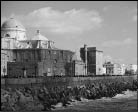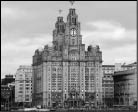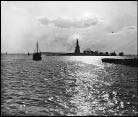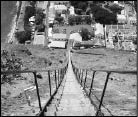Atlantic (19 page)
Authors: Simon Winchester

But yes, it was all there, large and looming and pink with Moroccan desert dust, and it was quite the spectacle I had imagined, full of symbolism and portent. Yet somehow it did not quite rival the thrill that Cádiz was feeling at the time I left there, just a few days before—because it turned out there had been a curious occurrence: a fire had broken out in an old part of what was already a very old city, some necessary demolitions had been carried out, and on the first blue-washed seaside morning I spent in the city, the maître d’ in the Hotel Atlántico could hardly suppress his excitement with that morning’s news:
They have found the ruins of a Roman theater!
he whispered to me as he handed me my pair of boiled eggs.
It is maybe the biggest in the world!
The second largest, as it happens.
35
But the discovery of a structure built by one of Julius Caesar’s lieutenants in the first century
B.C.
gave concrete form to this otherwise modestly self-effacing city’s notion of itself as a place of once great importance and antiquity. The Romans had used Cádiz as a naval base, and here was proof that they had had the wherewithal to entertain their sailors. The Carthaginians had done much the same, and before them the Phoenicians—who named it Gadir, the
walled place.
It had been a city of substance well before the Atlantic was even known to be an ocean.
The old center of Cádiz is on a slender spit of land between the ocean and the bay. At the seaward tip there is a fort, with thick walls and cannon and barbicans with slit windows from which wardens could once stand sentry over the sea. Immediately inside the walls is a rabbit warren of old structures, most dating from the seventeenth and eighteenth centuries. Beyond there are mansions and palaces and grand plazas, all built from the accumulated wealth of the two centuries when Cádiz was the principal Iberian entrepôt for commerce with the Americas.
I chose as the starting point of my long march east the plaque under the palms in the Plaza del Candelaria that marked the house of Bernardo O’Higgins, the Irish-Chilean who in the nineteenth century freed Chile from Spanish rule. I first strolled beneath the small scattering of towers from which merchants’ wives once used to spy for homebound ships, much as New Englanders’ spouses in later years gazed down from their widow’s walks. I walked past the old tobacco warehouse, past the impeccably preserved cathedral and the convent, and finally out onto the great south road—the Roman theater under its protective tarpaulins to my left, the causeway to the Andalusian mainland and the road to Gibraltar stretching hot and dusty ahead. I managed to get a little lost, and asked an elegant and elderly Spaniard for directions. He was less haughty than he looked, and not at all brusque:
Keep the ocean on your right hand,
he said,
and you can’t go far wrong. And mind you keep a lookout for Africa on the way!




The oceanfront has been dignified for centuries by architecture that reflects an enduring respect for the sea. Cádiz has reminders of traders and explorers dating from Phoenician and Roman times. There is a muscularly commercial aspect to
New York and Liverpool, and Jamestown
, on the mid-ocean island of St. Helena, has provided for three centuries a Georgian sanctuary in miniature for passing merchants.
Hispaniola’s sprawling city of Santo Domingo, three thousand miles away across the ocean to the west, has few such obvious charms, at least initially. Well over two million people are crowded into what is a generally ugly and uninspiring capital of an irredeemably corrupt and venal island (shared with Haiti, and lying between Puerto Rico and Cuba). But on the right bank of the Ozama River there is the old quarter, the reliquary of the city that Bartholomew Columbus, the brother of the explorer, founded in 1496, and which was rebuilt after a devastating hurricane four years later. And it is much more the kind of thing one hoped for.
Such buildings as remain show just how grand, how very much like Cádiz, this city could have come to look. As recently as a century and a half ago the
ciudad colonial
—formally known as Santo Domingo de Guzman, and in fact first named La Isabella in honor of the expedition’s sponsoring queen—was still recognizable as an iconically Atlantic city. There was a huge seawall, the waves crashing noisily below. There was a dock, and a lighthouse, and within the walls a barracks, a powder magazine, and a signal tower. A brief orgy of early-sixteenth-century colonial building then brought an enormous and handsomely styled palace of government, a decently proportioned cathedral, a private merchant’s mansion or two, a monastery, a hospital, and even more mundane but elegant structures—a warehouse, a slaughterhouse. On the landward side a great gateway pierced the wall with oak doors and two castellated towers, and from which Spanish troops could fan out on expeditions into the Hispaniolan hinterland.
Santo Domingo was in so many ways a classic of the oceanside fortress town: the narrow streets laid out in a perfect grid, all the essentials of expatriate life and imperial expansion crammed together along them within the protective walls of coral limestone blocks carved three feet thick. What little remains is well protected now: the United Nations sees that its unique standing is kept secure for the benefit of all, and that the great buildings—the First Cathedral in America, the First Castle in America, the First Palace in America—are kept beyond the reach of the developers who have so scarred the capital beyond with their skyscrapers and shopping centers. There are cobbled streets and a bustling Plaza de Espana; seagulls from the sea outside the walls swoop and skirl in the breezes.
Anyone walking at evening time high on the walls beside the iron-black cannon can feel very much at one with some stroller who might be in Cádiz, half a world away. This, one might be tempted to whisper across the sea to the other, is the way that the first cities of the Atlantic must have looked and felt and sounded in their first days. The tramp and clang of iron-shod infantry boots on polished limestone sett-stones, the importuning calls of merchants, the creak of ships’ timbers and mooring ropes, the cries of the seabirds, the endless grumbling crash of the rollers and the sea beyond, all bathed in the warm seaside light of early morning or late evening, salmon pink on the high coral walls. Cádiz and Santo Domingo might at such a moment be the selfsame city, linked in style and feeling by the men who first built them, and then by the ocean they have risen beside.
• • •
And then there are mighty Atlantic cities of today, New York incomparable among them. America’s “sea-washed sunset gates,” as Emma Lazarus has it in her famous inscription for the Statue of Liberty, remains today what it has been for more than a hundred and fifty years: the entranceway to hope and opportunity for millions upon millions of transatlantic peoples. To be sure, it is the great airports that bring in most of the migrants today, and most from far beyond the Atlantic, but the story of today’s New York is still in its essentials that of the great funnel opening into which the huddled masses from the storied pomp of old Europe were poured without cease from the middle of the nineteenth century until today.
Even now, the vision of New York as a great harbor city can be powerfully felt. Just below the massive concrete anchor points of the Verrazano Narrows Bridge, in Brooklyn, beside a stretch of truck-thundering concrete known as Leif Ericson Drive, is a sorry patch of worn grassland, and from there one can be close enough to the passing ships almost, but for an iron railing, to be able to reach out and touch their hulls. And what an endless procession they make! Bulk carriers from the African ports, fully laden and headed for the wharves of Bayonne, New Jersey. Sleek container ships from Gothenburg, filled no doubt with cheap Ikea furniture bound for the quay beside the main store in Elizabeth, New Jersey; blinding white and windowless car carriers from the assembly plants in Belgium and France headed for the docks along the Port Newark Channel; oil tankers heading gingerly up channel for the tank farms south of Kearny; and maybe even a liner, a still-elegant Cunarder perhaps, or else a more vulgar-looking and alarmingly top-heavy ship from Carnival headed for the piers on the west side of Manhattan, or the newly furbished terminal at Red Hook, Brooklyn, right by the tiny factory where some say the best Key lime pies in all America are made.
The outbound ships thunder slowly past, too, their gigantic screws thrashing through the waves as they head past Sea Gate and Breezy Point in New York, and past Sandy Hook and the low hills known rather generously as the Atlantic Highlands in New Jersey, past the highly secure navy piers where ocean-bound American warships are loaded with ammunition, out into the standing swells of the Atlantic. The smell of the sea margin is everywhere, and except on the sultriest of summer days there seems always to be a good breeze, and there are dozens of smaller craft scurrying about between the mighty ones, like those insects that as children we called waterboatmen. Police and coast guard tenders are lurking there, too, just in case, with uniformed officers at the helm and engines capable of great speed idling quietly.
And then behind is the roadway, with its informal spelling of the Norwegian who first crossed this ocean, and on it are streams of trucks and private cars and yellow taxis, mostly coming back from Kennedy Airport the long way, because of reported traffic jams on the amusingly misnamed Van Wyck Expressway. Few taxis will care to stop, but if one can be persuaded to, then it is a mere five more westbound minutes to pass beneath the Brooklyn Esplanade, then up over the gossamer basket of the Brooklyn Bridge, to where suddenly in front rises the glittering crystal wall of Manhattan, like a curtain in a spectacular theater. I once brought a young Filipina woman here after a long flight from Manila. It was a crisp winter’s day, and when she saw the first snow of her life, and then touched it for the first time, she shrieked with a mixture of shock and delight. But when she first saw Manhattan—and it was late afternoon, and the first lights were begin to prick like diamonds in the windows of a thousand buildings—her eyes became as wide as dinner plates, she cried out, and then she burst into floods of tears.
